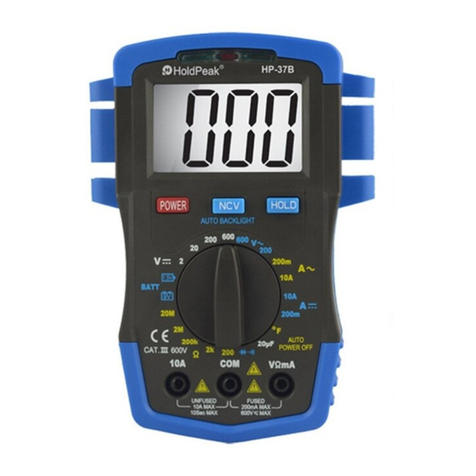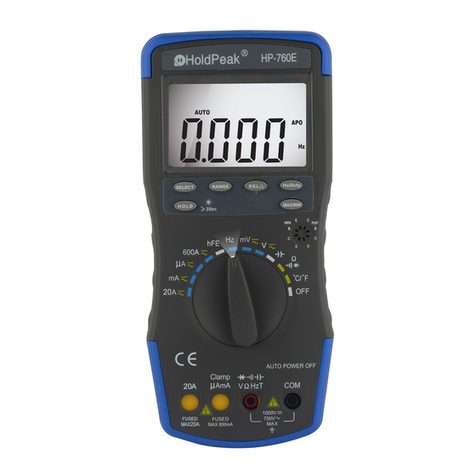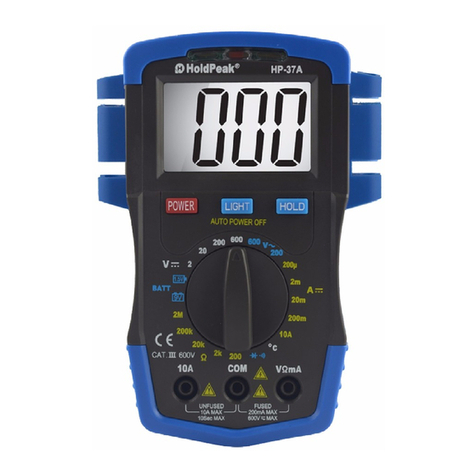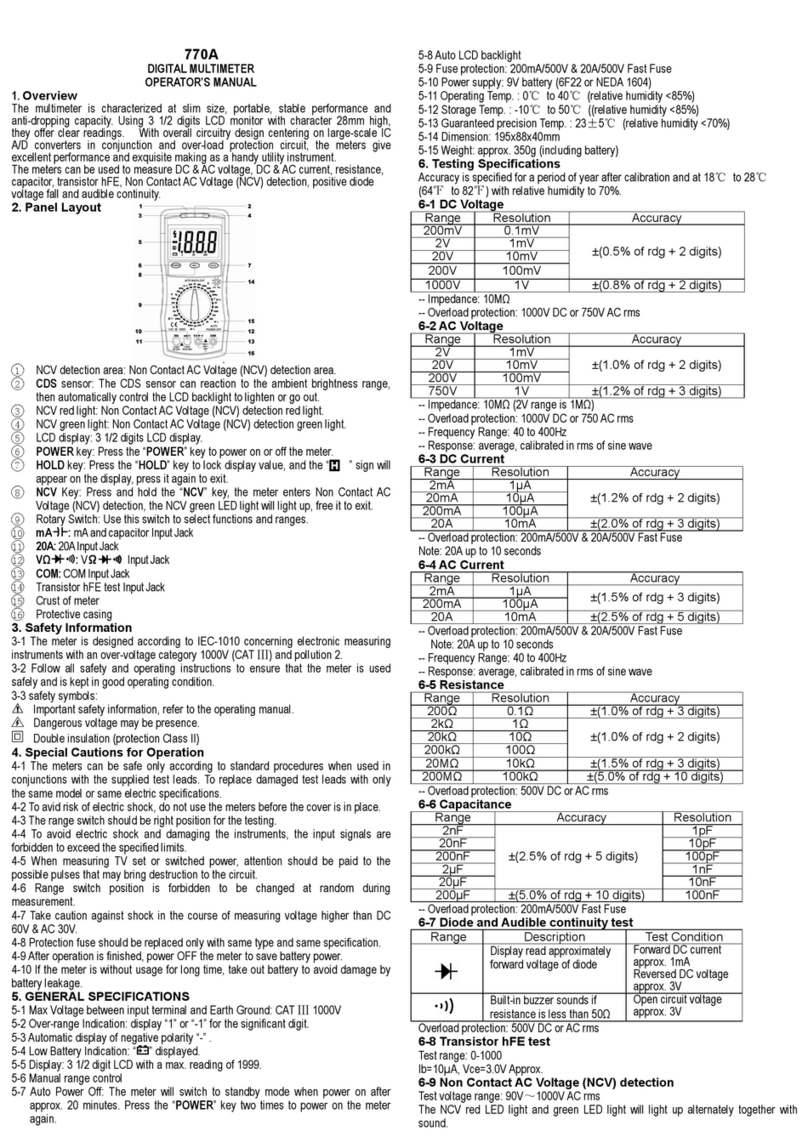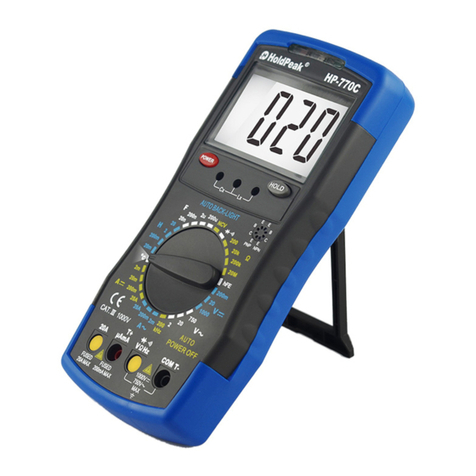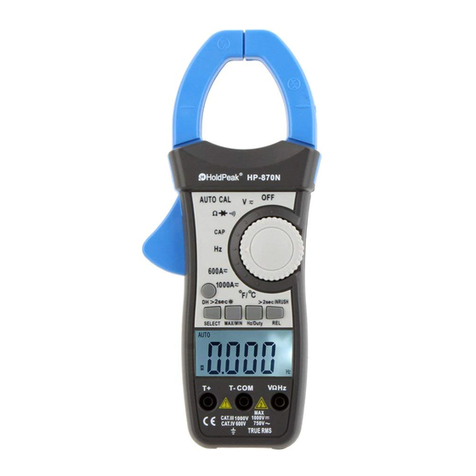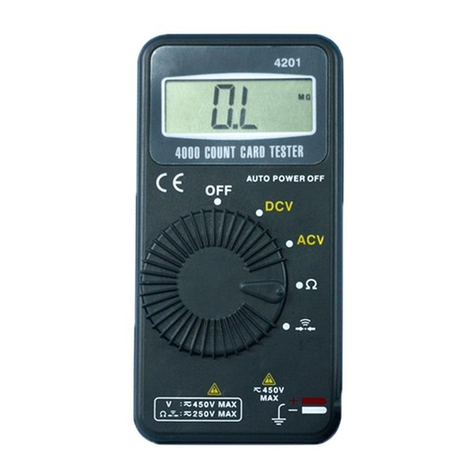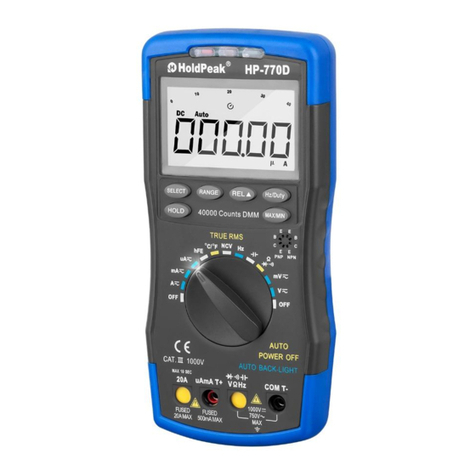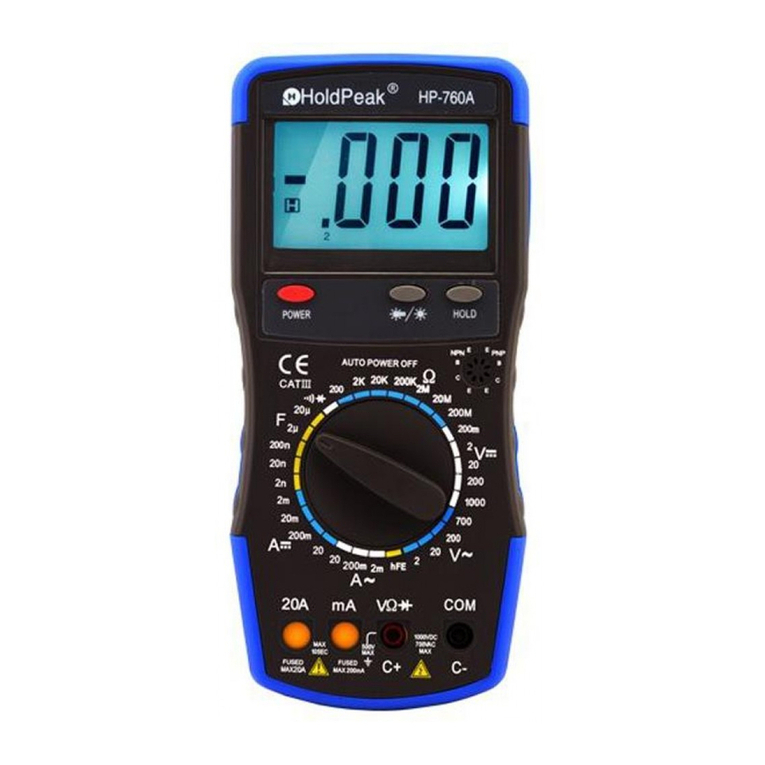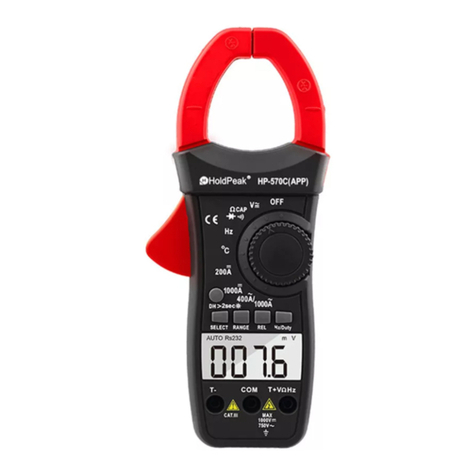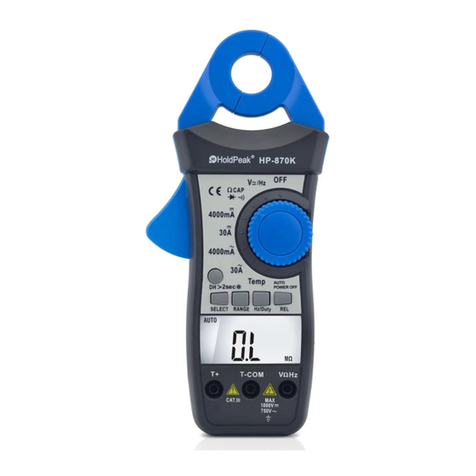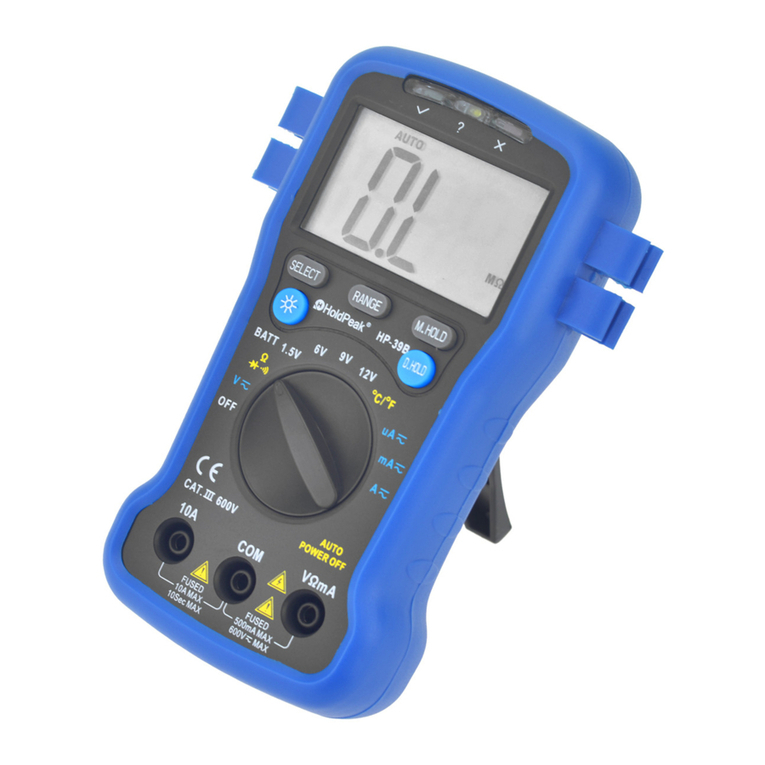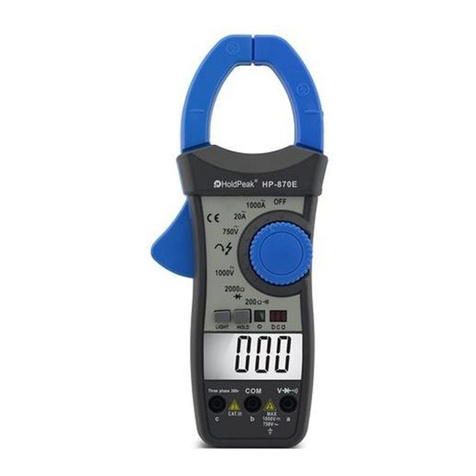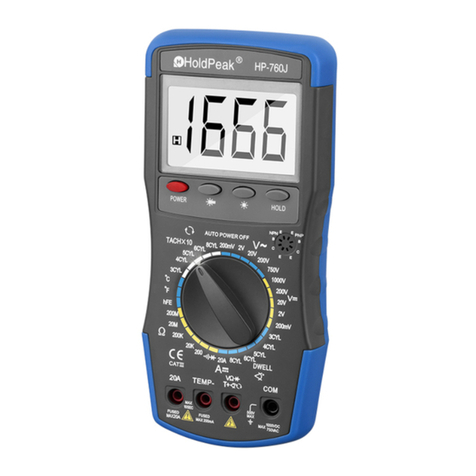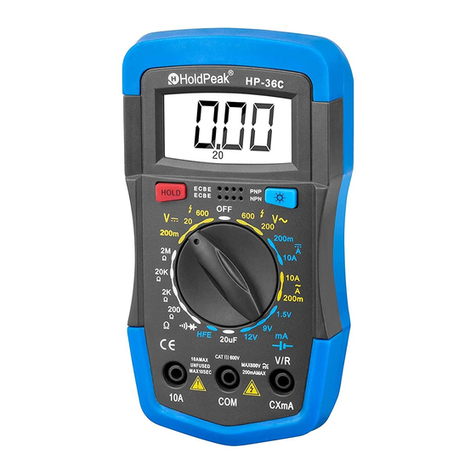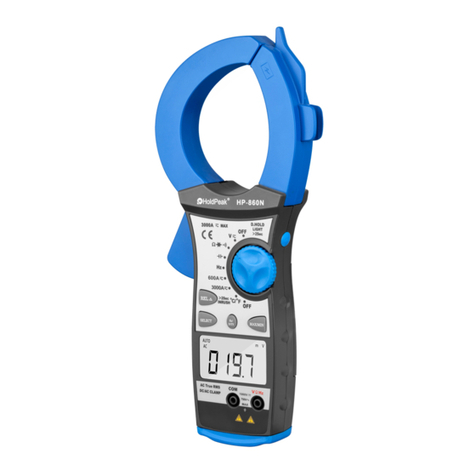Overload protection: 250V DC/250Vrms AC
4. MEASURING INSTRUCTION
4.1 Voltage measurement
1) Connect the black test lead to "COM" socket and red test lead
to the "VΩT+" socket.
2) Set the Rotary Switch to desired " V " position, Push the
SELECT button to select DC or AC test , and connect the probes
across the source or load under measurement.
3) Read the result from the LCD panel.
4.2 DC Current Measurement
1) Set the Rotary Switch to desired "60A "or "600A "
position, Push the SELECT button to select DC test.
2) Press the "REL" the display show "0".
Note:
As the jaw core may remain some magnetic force after using for
a while. If the display can not reach "0" When Press the "REL”,
please take following process to correct it:
A. To change the direction of the measured DC current.
B. Open the JAWS several times.
C. If the result display "OL" When measuring DCA, please
turn the direction of the clamp and measuring again. For
insure veracity of measuring, please select "600A" when the
object DCA over 60A.
3) Open the clamp by pressing the jaw-opening handle and insert
the cable (one cable only) to be measured into the jaw.
4) Close the clamp and get the reading from the LCD panel.
Note:
a) Before this measurement, disconnect the test lead with the
meter for safety.
b) In same occasion that the reading is hard to read, push the
D.HOLD button and read the result later.
4.3 AC Current measurement
1) Set the Rotary Switch to desired "60A "or "600A "
position, Push the SELECT button to select AC test.
2) Open the clamp by pressing the jaw-opening handle and insert
the cable (one cable only) to be measured into the jaw.
3) Close the clamp and get the reading from the LCD panel.
Note:
a) Before this measurement, disconnect the test lead with the
meter for safety.
b) In same occasion that the reading is hard to read, push the
D.HOLD button and read the result later.
4.4 Resistance measurement
1) Connect the black test lead to "COM" socket and red test lead
to the " VΩT+" socket.
2) Set the Rotary Switch to desired "Ω " position, the present
function is resistance measurement, if it is other function,
push the the SEL button to select resistance measurement.
3) Connect the probes across circuit to be tested.
4) Read the result from the LCD panel.
Caution: Ensure that the circuit to be tested is "dead".
Max.input over-load: 250V rms<10sec
4.5 Capacitance measurement
1) Connect the black test lead to "COM" socket and red test lead
to the " VΩT+" socket.
2)Set the Rotary Switch to desired "CAP" position
3) Connect the probes to the capacitance to be tested.
4) Read the result from the LCD panel.
Caution:
a) Capacitors should be discharged before being tested.
b) When testing large capacitance, it will take longer time before
the final indication (For 1uF~99.99mF range, it will take about
4~7 seconds).
c) When testing small capacitance, to assur the measurement
accuracy, first press "REL", then go on measureing.
Max.input over-load: 250V rms<10sec
4.6 Frequency/Duty measurement
1) Connect the black test lead to "COM" socket and red test lead
to the " VΩT+" socket (test at current range, do not) .
2) Set the Rotary Switch to ACV or ACA range, Connect the
probes to the point of measurement ;
3) push the Hz/Duty key to select Frequency or Duty test.
4) read the frequency or Duty from the display.
Max.input over-load: 250V rms<10sec
4.7 Temperature measurement
1) Connect the black test lead of the sensor to "T-" socket and
the red test lead to the " VΩT+" socket.
2) Set the Rotary Switch to "℃/℉" position.
3) Push the SELECT button to select ℃OR ℉test ,Put the
sensor probe into the temperature field under measurement.
4) Read the result from the LCD panel.
Max.input over-load: 250V rms<10sec
A.The temperature function shows the ambient temperature
when did not insert the thermocouple.
B.This meter inclosure WRNM-010 type contact thermocouple
limit temperature is 250 ℃(300 ℃shortly ) ;
C.Please don't change the thermocouple at will , otherwise we
can't guarantee to measure accuracy ;
D.Please don’t importing the voltage in the temperature function .
E.Please use special probe for test high temperature.
4.8 Diode test
1) Connect the black test lead to "COM" socket and red test lead
to the " VΩT+" socket.
2) Set the Rotary Switch to "Ω " position.
3) Push "SELECT" to select diode test.
4) Connect the black and red test probe to the cathode (-)
and anode (+) ends of diode to be tested
repectively, read the forward voltage drop (junction) value
from the display. If reverse connected the probes to diode,
display shows over-load.
Caution: Ensure that the circuit to be tested is "dead".
Max.input over-load: 250V rms<10sec
4.9 Audible continuty test
1) Connect the black test lead to "COM" socket and red test lead
to the " VΩT+" socket.
2) Set the Rotary Switch to "Ω " position.
3) Push "SELECT" to select audible continuty test.
4) Connect the probes across circuit to be tested, the beeper
sounds continuously if the resistance is less than approx. 50Ω.
Caution: Ensure that the circuit to be tested is "dead".
Max.input over-load: 250V rms<10sec
4.9 NCV test
1) Set the Rotary Switch to "NCV" position, The meter display EF.
2) Put the left clamp close to the wire or conductor by test.
3) the LED flashing and the beeper sounds, the LED flashing
speed said the ac voltage high or low.
4.11 Relative measurement
Press "REL", you can measure the relative value and "REL"
appears on the display, the auto range mode be changed to
manual range mode. Press again, return to the revious
condition and "REL" disappears, but you can not go back to
auto range mode. In” Hz” measurement, you can not measure
the relative value.
5. CARE AND MAINTENANCE
5.1 CARING FOR YOUR MULTIMETER
Your Digital Multimeter is an example of superior design and
craftsmanship. The following suggestions will help you care for
the multimeter so you can enjoy it for years.
1) Keep the multimeter dry. If it gets wet, wipe it dry immediately.
Liquids can contain minerals that can corrode electronic circuits.
2) Use and store the multimeter onlyin normal temperature
environments. Temperature extremes can shorten the life of
electronic devices, damage batteries and distortor melt plastic parts.
3) Handle the multimeter gently and carefully. Dropping it can
damage the circuit boards and case, and can accuse the
multimeter to work improperly.
4) When take current measurement, keep the cable at the center
of the clamp will get more accurate test result.
5) Keep the multimeter away from dust and dirt, which can cause
premature wear of parts.
6) Wipe the mutimeter with a damp cloth occasionally to keep it
looking new. Do not use harsh chemicals, cleaning solvents, or
strong detergents to clean the multimeter.
7) Use only fresh batteries of the required size and type. Always
remove old or weak batteries. They can leak chemicals that
destroy electronic circuits.
8) Please take out the battery when not using for a long time.
5.2 1.5-Volt battery replacement
1)Ensure the instrument is not connected to any external circuit.
Set the Rotary Switch to OFF position and remove the test leads
from the terminals.
2)Open the cover of the battery cabinet by a screwdriver.
3)Replace the old batteries with the same type batteries.
4)Close the battery cabinet cover and fasten the screw.
